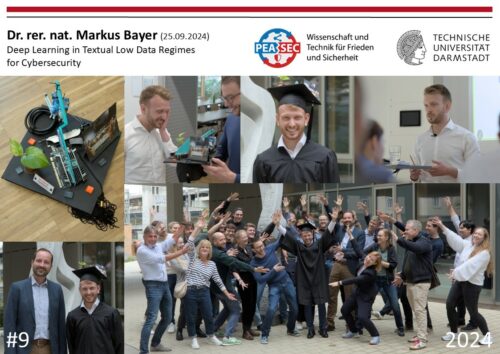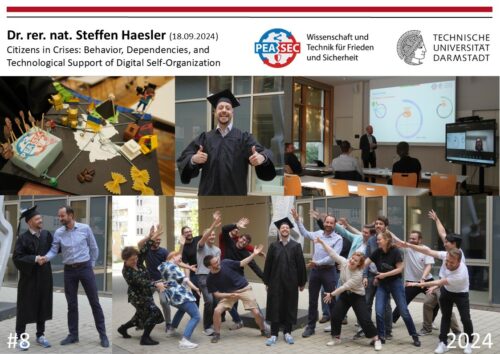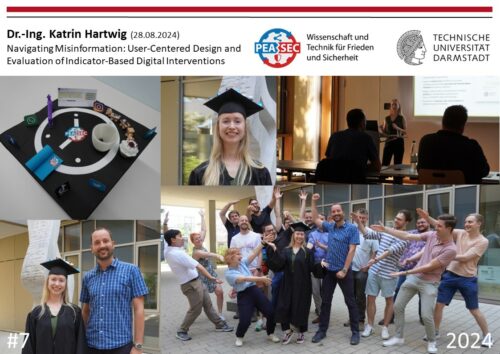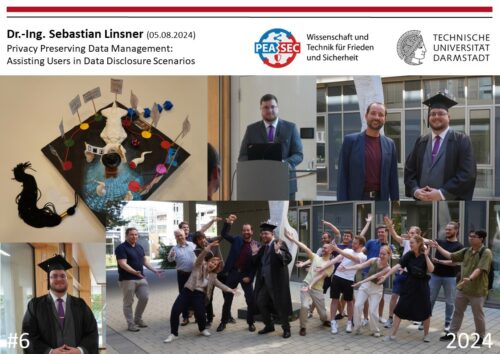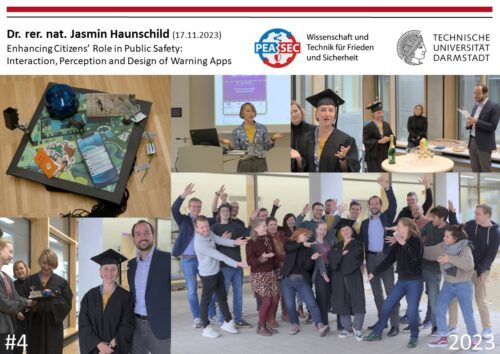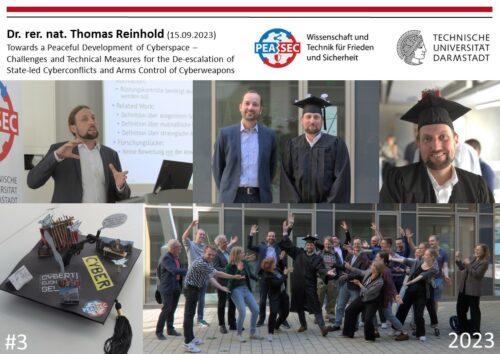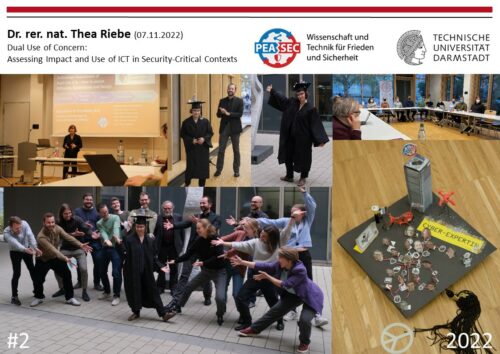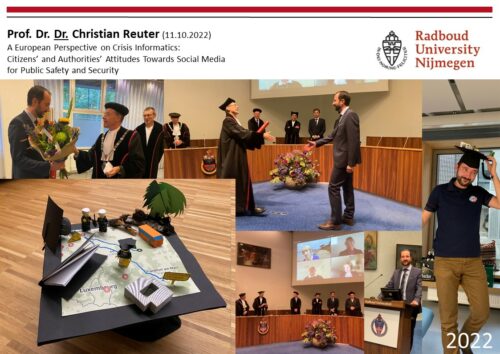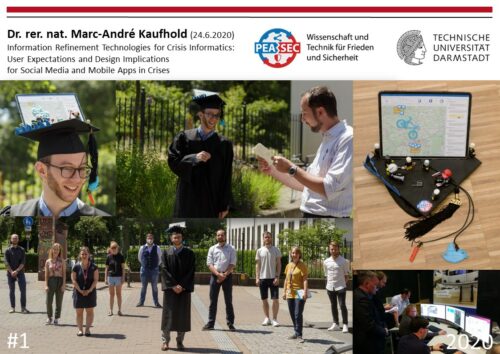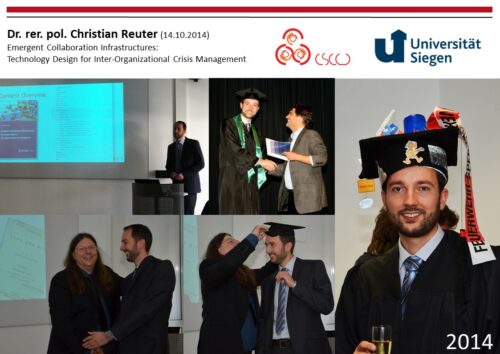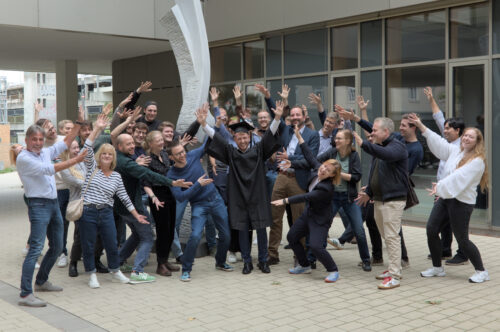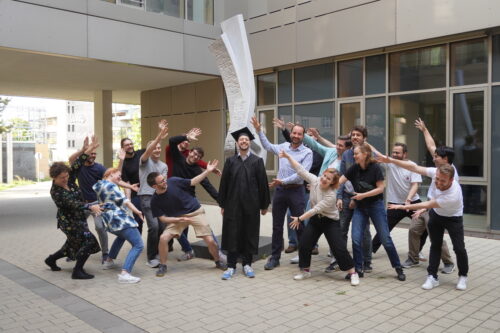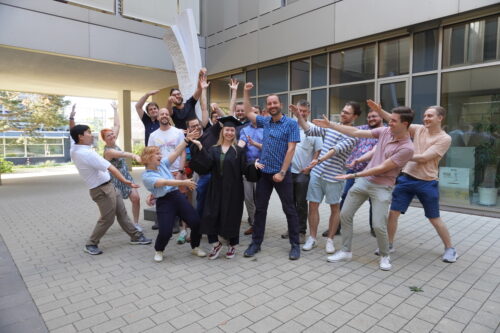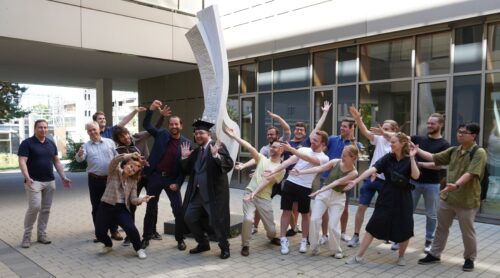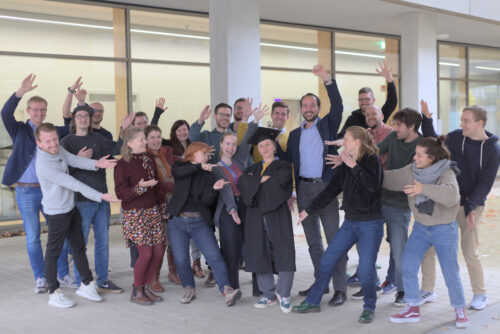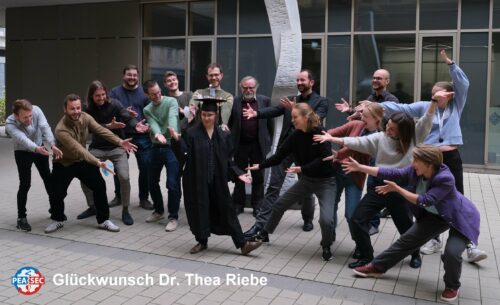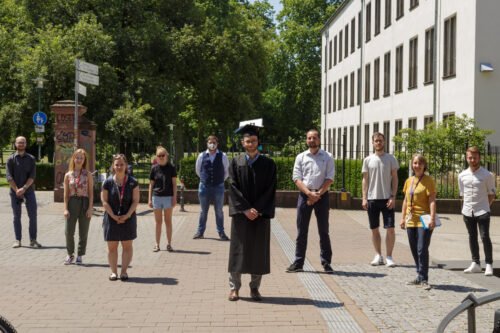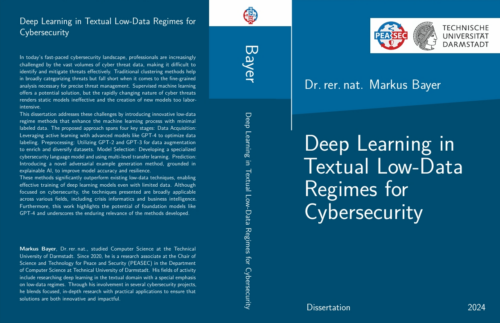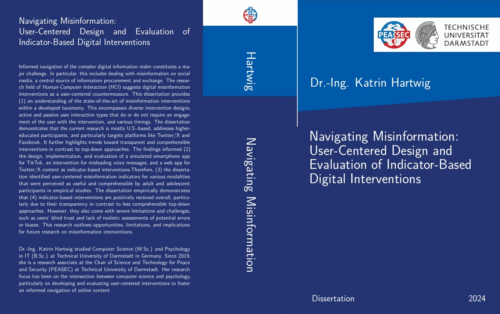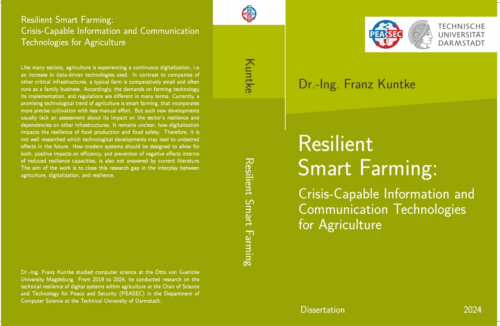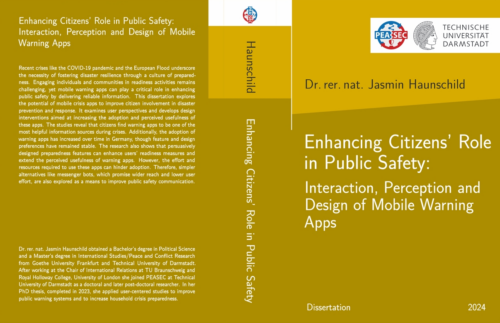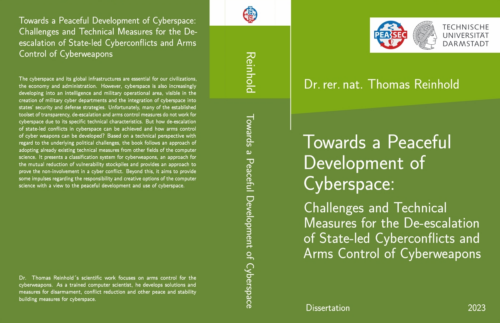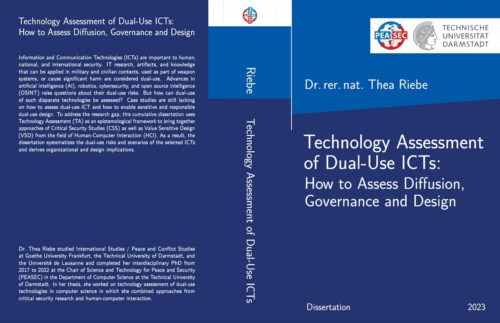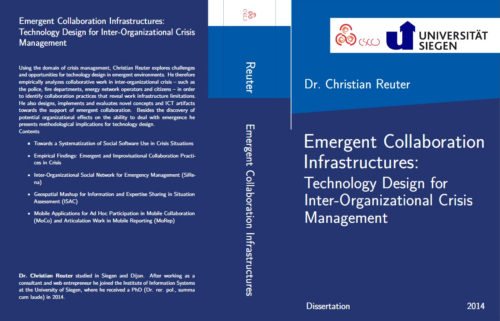Overview about finished PhD Theses
Collage
Group Picture
Book Cover
News with regard to PhD theses
Published PhD Theses:
The work is often published both on the publication server of TU Darmstadt (tuprints), and in a publishing house (usually in the book series Technology, Peace, Security published by the chair with Springer Vieweg).
Publishing Server
Publishing Server
[BibTeX]
@book{schmid_governing_2025-1,
address = {Darmstadt, Germany},
title = {Governing ({In}){Security}: {Socio}-technical {Interactions} in {International} {Relations}},
publisher = {Dissertation (Dr. phil.), Department of History and Social Sciences, Technische Universität Darmstadt},
author = {Schmid, Stefka},
year = {2025},
keywords = {Crisis, Peace, Projekt-NEBULA, Projekt-TraCe, Dissertation},
}[BibTeX] [Abstract] [Download PDF]
Like many sectors, agriculture is experiencing a continuous digitalization, i.e. an increase in data-driven technologies used. In contrast to companies of other critical infrastructures – e.g. energy or telecommunication – a typical farm is comparatively small and often run as a family business. Accordingly, the demands on farming technology, its implementation, and regulations are different in many terms. Furthermore, the circumstances that influence crisis risks and crisis management are different in agriculture – and as digitalization introduces new potential risks, this process should be reviewed critically. Currently, the most advanced approaches for agriculture are typically referred to as smart farming and agriculture 4.0, which incorporate more precise cultivation with less manual effort. But such new agriculture technology developments usually lack an assessment about its impact on the sector’s resilience and dependencies on other infrastructures. The research domains of crisis informatics and IT security mostly focuses on other topics, apart from agriculture. The resilience research in agriculture itself is currently intensifying, however, this line of research focuses more on problems resulting from the climate crisis and social change. For these reasons it remains unclear, how digitalization impacts the resilience of food production and food safety. Therefore, it is not well researched which technological developments may lead to undesired effects in the future. How modern systems should be designed to allow for both, positive impacts on efficiency, and prevention of negative effects in terms of reduced resilience capacities, is also not answered by current literature. The aim of the present work is to close this research gap at the intersection of agriculture, digitalization, and resilience. To answer the question to what extent current technologies used by farmers are at risk of failure, the dissertation first presents a snapshot of the resilience state of agricultural companies and the technologies used. This involves interviews with stakeholders, mainly farmers, as well as surveying security issues of the LoRaWAN protocol, a transmission technology especially useful for agricultural Internet of Things. Which desires of farmers exist regarding software focusing on aspects of business continuity and secured operations, is another open question. This dissertation aims to also answer this question with empirical methods, mainly focus groups and usability tests. Then the rise of Internet of Things in agriculture raises another question, whether such technologies acquired for smart farming could also have benefits for resilience against internet-connection-lost situations. This question is answered by empirical evaluation of LoRaWAN range characteristics in agricultural landscapes, as well as artifact generation for resilient communication channels on top of LoRaWAN transmission devices. Several findings are derived from the conducted research: There is a lack of understanding of how strong the used tools in agriculture depend on ICT, and many tools require a working internet connection. Moreover, IT employed by agricultural enterprises presents security concerns similar to those encountered in other domains. Based on these findings, developments, and evaluations of new software approaches are presented: Derived design criteria and own system designs that allow for modern data-driven business operations, including IoT integration based on LoRaWAN. The developed solutions show an increase in resilience capacities by enhancing the communication possibilities in crisis situations. The detected low absorption capacities against communication infrastructure outages shows room for improvement. To improve agricultural ITs‘ resilience, software engineers could use the concepts and designs of this dissertation for their product development, like a modular offline-capable farm management storage that allows an exchange of small data in an autarkic manner via commodity LoRaWAN hardware. But also technology advisors and farmers benefit from the technological analyses and suggestions embedded in this work, like using multiple LoRaWAN gateways with an overlapping coverage to mitigate security vulnerabilities.
@book{kuntke_resilient_2024-1,
address = {Darmstadt, Germany},
title = {Resilient {Smart} {Farming}: {Crisis}-{Capable} {Information} and {Communication} {Technologies} for {Agriculture}},
url = {http://tuprints.ulb.tu-darmstadt.de/26496/},
abstract = {Like many sectors, agriculture is experiencing a continuous digitalization, i.e. an increase in data-driven technologies used. In contrast to companies of other critical infrastructures – e.g. energy or telecommunication – a typical farm is comparatively small and often run as a family business.
Accordingly, the demands on farming technology, its implementation, and regulations are different in many terms.
Furthermore, the circumstances that influence crisis risks and crisis management are different in agriculture – and as digitalization introduces new potential risks, this process should be reviewed critically.
Currently, the most advanced approaches for agriculture are typically referred to as smart farming and agriculture 4.0, which incorporate more precise cultivation with less manual effort.
But such new agriculture technology developments usually lack an assessment about its impact on the sector's resilience and dependencies on other infrastructures.
The research domains of crisis informatics and IT security mostly focuses on other topics, apart from agriculture.
The resilience research in agriculture itself is currently intensifying, however, this line of research focuses more on problems resulting from the climate crisis and social change.
For these reasons it remains unclear, how digitalization impacts the resilience of food production and food safety.
Therefore, it is not well researched which technological developments may lead to undesired effects in the future.
How modern systems should be designed to allow for both, positive impacts on efficiency, and prevention of negative effects in terms of reduced resilience capacities, is also not answered by current literature.
The aim of the present work is to close this research gap at the intersection of agriculture, digitalization, and resilience.
To answer the question to what extent current technologies used by farmers are at risk of failure, the dissertation first presents a snapshot of the resilience state of agricultural companies and the technologies used.
This involves interviews with stakeholders, mainly farmers, as well as surveying security issues of the LoRaWAN protocol, a transmission technology especially useful for agricultural Internet of Things.
Which desires of farmers exist regarding software focusing on aspects of business continuity and secured operations, is another open question.
This dissertation aims to also answer this question with empirical methods, mainly focus groups and usability tests.
Then the rise of Internet of Things in agriculture raises another question, whether such technologies acquired for smart farming could also have benefits for resilience against internet-connection-lost situations.
This question is answered by empirical evaluation of LoRaWAN range characteristics in agricultural landscapes, as well as artifact generation for resilient communication channels on top of LoRaWAN transmission devices.
Several findings are derived from the conducted research:
There is a lack of understanding of how strong the used tools in agriculture depend on ICT, and many tools require a working internet connection.
Moreover, IT employed by agricultural enterprises presents security concerns similar to those encountered in other domains.
Based on these findings, developments, and evaluations of new software approaches are presented:
Derived design criteria and own system designs that allow for modern data-driven business operations, including IoT integration based on LoRaWAN.
The developed solutions show an increase in resilience capacities by enhancing the communication possibilities in crisis situations.
The detected low absorption capacities against communication infrastructure outages shows room for improvement.
To improve agricultural ITs' resilience, software engineers could use the concepts and designs of this dissertation for their product development, like a modular offline-capable farm management storage that allows an exchange of small data in an autarkic manner via commodity LoRaWAN hardware.
But also technology advisors and farmers benefit from the technological analyses and suggestions embedded in this work, like using multiple LoRaWAN gateways with an overlapping coverage to mitigate security vulnerabilities.},
publisher = {Dissertation (Dr.-Ing.), Department of Computer Science, Technische Universität Darmstadt},
author = {Kuntke, Franz},
year = {2024},
doi = {10.26083/tuprints-00026496},
keywords = {Crisis, HCI, Security, UsableSec, Projekt-AgriRegio, Projekt-GeoBox, RSF, Dissertation},
}[BibTeX]
@book{haunschild_enhancing_2024,
address = {Darmstadt, Germany},
title = {Enhancing {Citizens}’ {Role} in {Public} {Safety}: {Interaction}, {Perception} and {Design} of {Mobile} {Warning} {Apps}},
publisher = {Dissertation (Dr. rer. nat.), Department of Computer Science, Technische Universität Darmstadt},
author = {Haunschild, Jasmin},
year = {2024},
keywords = {Crisis, HCI, Projekt-emergenCITY, Projekt-ATHENE-SecUrban, Dissertation},
}[BibTeX]
@book{haesler_citizens_2024,
address = {Darmstadt, Germany},
title = {Citizens in {Crises}: {Behavior}, {Dependencies}, and {Technological} {Support} of {Digital} {Self}-{Organization}},
publisher = {Dissertation (Dr. rer. nat.), Department of Computer Science, Technische Universität Darmstadt},
author = {Haesler, Steffen},
year = {2024},
keywords = {Crisis, HCI, Projekt-emergenCITY, Dissertation},
}[BibTeX]
@book{linsner_privacy_2024,
address = {Darmstadt, Germany},
title = {Privacy {Preserving} {Data} {Management} – {Assisting} {Users} in {Data} {Disclosure} {Scenarios}},
publisher = {Dissertation (Dr.-Ing.), Department of Computer Science, Technische Universität Darmstadt},
author = {Linsner, Sebastian},
year = {2024},
keywords = {Security, UsableSec, Projekt-ATHENE-PriVis, Projekt-CROSSING, Dissertation},
}[BibTeX]
@book{hartwig_navigating_2024,
address = {Darmstadt, Germany},
title = {Navigating {Misinformation}: {User}-{Centered} {Design} and {Evaluation} of {Indicator}-{Based} {Digital} {Interventions}},
publisher = {Dissertation (Dr.-Ing.), Department of Computer Science, Technische Universität Darmstadt},
author = {Hartwig, Katrin},
year = {2024},
keywords = {Crisis, HCI, Projekt-NEBULA, Dissertation},
}[BibTeX]
@book{bayer_deep_2024,
address = {Darmstadt, Germany},
title = {Deep {Learning} in {Textual} {Low}-{Data} {Regimes} for {Cybersecurity}},
publisher = {Dissertation (Dr. rer. nat.), Department of Computer Science, Technische Universität Darmstadt},
author = {Bayer, Markus},
year = {2024},
keywords = {Projekt-ATHENE-CyAware, Security, Projekt-CYLENCE, Projekt-CYWARN, Dissertation},
}[BibTeX] [Abstract] [Download PDF]
Cyberspace, already a few decades old, has become a matter of course for most of us, part of our everyday life. At the same time, this space and the global infrastructure behind it are essential for our civilizations, the economy and administration, and thus an essential expression and lifeline of a globalized world. However, these developments also create vulnerabilities and thus, cyberspace is increasingly developing into an intelligence and military operational area – for the defense and security of states but also as a component of offensive military planning, visible in the creation of military cyber-departments and the integration of cyberspace into states‘ security and defense strategies. In order to contain and regulate the conflict and escalation potential of technology used by military forces, over the last decades, a complex tool set of transparency, de-escalation and arms control measures has been developed and proof-tested. Unfortunately, many of these established measures do not work for cyberspace due to its specific technical characteristics. Even more, the concept of what constitutes a weapon – an essential requirement for regulation – starts to blur for this domain. Against this background, this thesis aims to answer how measures for the de-escalation of state-led conflicts in cyberspace and arms control of cyberweapons can be developed. In order to answer this question, the dissertation takes a specifically technical perspective on these problems and the underlying political challenges of state behavior and international humanitarian law in cyberspace to identify starting points for technical measures of transparency, arms control and verification. Based on this approach of adopting already existing technical measures from other fields of computer science, the thesis will provide proof of concepts approaches for some mentioned challenges like a classification system for cyberweapons that is based on technical measurable features, an approach for the mutual reduction of vulnerability stockpiles and an approach to plausibly assure the non-involvement in a cyberconflict as a measure for de-escalation. All these initial approaches and the questions of how and by which measures arms control and conflict reduction can work for cyberspace are still quite new and subject to not too many debates. Indeed, the approach of deliberately self-restricting the capabilities of technology in order to serve a bigger goal, like the reduction of its destructive usage, is yet not very common for the engineering thinking of computer science. Therefore, this dissertation also aims to provide some impulses regarding the responsibility and creative options of computer science with a view to the peaceful development and use of cyberspace.
@book{reinhold_towards_2023,
address = {Darmstadt, Germany},
title = {Towards a {Peaceful} {Development} of {Cyberspace}: {Challenges} and {Technical} {Measures} for the {De}-{Escalation} of {State}-{Led} {Cyberconflicts} and {Arms} {Control} of {Cyberweapons}},
url = {https://tuprints.ulb.tu-darmstadt.de/24559/},
abstract = {Cyberspace, already a few decades old, has become a matter of course for most of us, part of our everyday life. At the same time, this space and the global infrastructure behind it are essential for our civilizations, the economy and administration, and thus an essential expression and lifeline of a globalized world. However, these developments also create vulnerabilities and thus, cyberspace is increasingly developing into an intelligence and military operational area – for the defense and security of states but also as a component of offensive military planning, visible in the creation of military cyber-departments and the integration of cyberspace into states' security and defense strategies. In order to contain and regulate the conflict and escalation potential of technology used by military forces, over the last decades, a complex tool set of transparency, de-escalation and arms control measures has been developed and proof-tested. Unfortunately, many of these established measures do not work for cyberspace due to its specific technical characteristics. Even more, the concept of what constitutes a weapon – an essential requirement for regulation – starts to blur for this domain. Against this background, this thesis aims to answer how measures for the de-escalation of state-led conflicts in cyberspace and arms control of cyberweapons can be developed. In order to answer this question, the dissertation takes a specifically technical perspective on these problems and the underlying political challenges of state behavior and international humanitarian law in cyberspace to identify starting points for technical measures of transparency, arms control and verification. Based on this approach of adopting already existing technical measures from other fields of computer science, the thesis will provide proof of concepts approaches for some mentioned challenges like a classification system for cyberweapons that is based on technical measurable features, an approach for the mutual reduction of vulnerability stockpiles and an approach to plausibly assure the non-involvement in a cyberconflict as a measure for de-escalation. All these initial approaches and the questions of how and by which measures arms control and conflict reduction can work for cyberspace are still quite new and subject to not too many debates. Indeed, the approach of deliberately self-restricting the capabilities of technology in order to serve a bigger goal, like the reduction of its destructive usage, is yet not very common for the engineering thinking of computer science. Therefore, this dissertation also aims to provide some impulses regarding the responsibility and creative options of computer science with a view to the peaceful development and use of cyberspace.},
publisher = {Dissertation (Dr. rer. nat.), Department of Computer Science, Technische Universität Darmstadt},
author = {Reinhold, Thomas},
year = {2023},
doi = {10.26083/tuprints-00024559},
keywords = {Peace, Security, Projekt-ATHENE, Projekt-CROSSING, Dissertation},
}[BibTeX] [Abstract] [Download PDF]
Technologies that can be used in military and civilian applications are referred to as dual-use. The dual-use nature of many information and communications technologies (ICTs) raises new questions for research and development for national, international, and human security. Measures to deal with the risks associated with the various dual-use technologies, including proliferation control, design approaches, and policy measures, vary widely. For example, Autonomous Weapon Systems (AWS) have not yet been regulated, while cryptographic products are subject to export and import controls. Innovations in artificial intelligence (AI), robotics, cybersecurity, and automated analysis of publicly available data raise new questions about their respective dual-use risks. Dual-use risks have been systematically discussed so far, especially in the life sciences, which have contributed to the development of methods for assessment and risk management. Dual-use risks arise, among other things, from the fact that safety-critical technologies can be easily disseminated or modified, as well as used as part of a weapon system. Therefore, the development and adaptation of robots and software requires an independent consideration that builds on the insights of related dual-use discourses. Therefore, this dissertation considers the management of such risks in terms of the proliferation, regulation, and design of individual dual-use information technologies. Technology Assessment (TA) is the epistemological framework for this work, bringing together the concepts and approaches of Critical Security Studies (CSS) and Human-Computer Interaction (HCI) to help evaluate and shape dual-use technologies. In order to identify the diffusion of dual-use at an early stage, the dissertation first examines the diffusion of dual-use innovations between civilian and military research in expert networks on LinkedIn, as well as on the basis of AI patents in a patent network. The results show low diffusion and tend to confirm existing studies on diffusion in patent networks. In the following section, the regulation of dual-use technologies is examined in the paper through two case studies. The first study uses a discourse analysis to show the value conflicts with regard to the regulation of autonomous weapons systems using the concept of Meaningful Human Control (MHC), while a second study, as a long-term comparative case study, analyzes the change and consequences of the regulation of strong cryptography in the U.S. as well as the programs of intelligence agencies for mass surveillance. Both cases point to the central role of private companies, both in the production of AWS and as intermediaries for the dissemination of encryption, as well as surveillance intermediaries. Subsequently, the dissertation examines the design of a dual-use technology using an Open Source Intelligence System (OSINT) for cybersecurity. For this purpose, conceptual, empirical, and technical studies are conducted as part of the Value-Sensitive Design (VSD) framework. During the studies, implications for research on and design of OSINT were identified. For example, the representative survey of the German population has shown that transparency of use while reducing mistrust is associated with higher acceptance of such systems. Additionally, it has been shown that data sparsity through the use of expert networks has many positive effects, not only improving the performance of the system, but is also preferable for legal and social reasons. Thus, the work contributes to the understanding of specific dual-use risks of AI, the regulation of AWS and cryptography, and the design of OSINT in cybersecurity. By combining concepts from CSS and participatory design methods in HCI, this work provides an interdisciplinary and multi-method contribution.
@book{riebe_technology_2023-1,
address = {Darmstadt, Germany},
title = {Technology {Assessment} of {Dual}-{Use} {ICTs} – {How} to assess {Diffusion}, {Governance} and {Design}},
url = {https://tuprints.ulb.tu-darmstadt.de/22849/},
abstract = {Technologies that can be used in military and civilian applications are referred to as dual-use. The dual-use nature of many information and communications technologies (ICTs) raises new questions for research and development for national, international, and human security. Measures to deal with the risks associated with the various dual-use technologies, including proliferation control, design approaches, and policy measures, vary widely. For example, Autonomous Weapon Systems (AWS) have not yet been regulated, while cryptographic products are subject to export and import controls. Innovations in artificial intelligence (AI), robotics, cybersecurity, and automated analysis of publicly available data raise new questions about their respective dual-use risks.
Dual-use risks have been systematically discussed so far, especially in the life sciences, which have contributed to the development of methods for assessment and risk management. Dual-use risks arise, among other things, from the fact that safety-critical technologies can be easily disseminated or modified, as well as used as part of a weapon system. Therefore, the development and adaptation of robots and software requires an independent consideration that builds on the insights of related dual-use discourses. Therefore, this dissertation considers the management of such risks in terms of the proliferation, regulation, and design of individual dual-use information technologies. Technology Assessment (TA) is the epistemological framework for this work, bringing together the concepts and approaches of Critical Security Studies (CSS) and Human-Computer Interaction (HCI) to help evaluate and shape dual-use technologies.
In order to identify the diffusion of dual-use at an early stage, the dissertation first examines the diffusion of dual-use innovations between civilian and military research in expert networks on LinkedIn, as well as on the basis of AI patents in a patent network. The results show low diffusion and tend to confirm existing studies on diffusion in patent networks. In the following section, the regulation of dual-use technologies is examined in the paper through two case studies. The first study uses a discourse analysis to show the value conflicts with regard to the regulation of autonomous weapons systems using the concept of Meaningful Human Control (MHC), while a second study, as a long-term comparative case study, analyzes the change and consequences of the regulation of strong cryptography in the U.S. as well as the programs of intelligence agencies for mass surveillance. Both cases point to the central role of private companies, both in the production of AWS and as intermediaries for the dissemination of encryption, as well as surveillance intermediaries. Subsequently, the dissertation examines the design of a dual-use technology using an Open Source Intelligence System (OSINT) for cybersecurity. For this purpose, conceptual, empirical, and technical studies are conducted as part of the Value-Sensitive Design (VSD) framework. During the studies, implications for research on and design of OSINT were identified. For example, the representative survey of the German population has shown that transparency of use while reducing mistrust is associated with higher acceptance of such systems. Additionally, it has been shown that data sparsity through the use of expert networks has many positive effects, not only improving the performance of the system, but is also preferable for legal and social reasons. Thus, the work contributes to the understanding of specific dual-use risks of AI, the regulation of AWS and cryptography, and the design of OSINT in cybersecurity. By combining concepts from CSS and participatory design methods in HCI, this work provides an interdisciplinary and multi-method contribution.},
publisher = {Dissertation (Dr. rer. nat.), Department of Computer Science, Technische Universität Darmstadt},
author = {Riebe, Thea},
year = {2023},
doi = {10.26083/tuprints-00022849},
keywords = {HCI, Peace, Projekt-CYWARN, Dissertation, Projekt-DualUse, Projekt-KontiKat},
}[BibTeX] [Abstract] [Download PDF]
Mobilising helpers in the event of a flood or letting friends know that you are okay in the event of a terrorist attack – more and more people are using social media in emergency, crisis or disaster situations. Storms, floods, attacks or pandemics (esp. COVID-19) show that citizens use social media to inform themselves or to coordinate. This thesis presents qualitative and quantitative studies on the attitudes of emergency services and citizens in Europe towards social media in emergencies. Across the individual sub-studies, almost 10,000 people are surveyed including representative studies in the Netherlands, Germany, the UK and Italy. The work empirically shows that social media is increasingly important for emergency services, both for prevention and during crises; that private use of social media is a driving force in shaping opinions for organisational use; and that citizens have high expectations towards authorities, especially monitoring social media is expected, and sometimes responses within one hour. Depending on the risk culture, the data show further differences, e.g. whether the state (Germany) or the individual (Netherlands) is seen as primarily responsible for coping with the situation.
@book{reuter_european_2022,
address = {Nijmegen},
title = {A {European} {Perspective} on {Crisis} {Informatics}: {Citizens}' and {Authorities}' attitudes towards {Social} {Media} for {Public} {Safety} and {Security}},
url = {https://repository.ubn.ru.nl/handle/2066/253000},
abstract = {Mobilising helpers in the event of a flood or letting friends know that you are okay in the event of a terrorist attack – more and more people are using social media in emergency, crisis or disaster situations. Storms, floods, attacks or pandemics (esp. COVID-19) show that citizens use social media to inform themselves or to coordinate. This thesis presents qualitative and quantitative studies on the attitudes of emergency services and citizens in Europe towards social media in emergencies. Across the individual sub-studies, almost 10,000 people are surveyed including representative studies in the Netherlands, Germany, the UK and Italy. The work empirically shows that social media is increasingly important for emergency services, both for prevention and during crises; that private use of social media is a driving force in shaping opinions for organisational use; and that citizens have high expectations towards authorities, especially monitoring social media is expected, and sometimes responses within one hour. Depending on the risk culture, the data show further differences, e.g. whether the state (Germany) or the individual (Netherlands) is seen as primarily responsible for coping with the situation.},
publisher = {The Radboud University Thesis Repository},
author = {Reuter, Christian},
year = {2022},
doi = {10.1007/978-3-658-39720-3},
keywords = {Crisis, HCI, Projekt-emergenCITY, SocialMedia, Projekt-ATHENE-SecUrban, AuswahlCrisis, Selected, Dissertation, Projekt-EmerGent, Projekt-KontiKat},
}[BibTeX] [Abstract] [Download PDF]
In den letzten 20 Jahren haben sich mobile Technologien und soziale Medien nicht nur im Alltag, sondern auch in Krisensituationen etabliert. Insbesondere großflächige Ereignisse wie der Hurrikan Sandy (2012) oder das mitteleuropäische Hochwasser (2013) haben gezeigt, dass sich die Bevölkerung aktiv mit Informations- und Kommunikationstechnologie (IKT) an der Schadensbewältigung beteiligt (Reuter, Hughes, et al., 2018). Daraus ist das Forschungsfeld der Kriseninformatik entstanden, welches Wissen der Informatik und Gesellschaftswissenschaften kombiniert und zudem in Disziplinen wie der MenschMaschine-Interaktion (HCI), Computerunterstützten Gruppenarbeit (CSCW) und Wirtschaftsinformatik (WI) verankert ist. Während die Bevölkerung IKT einsetzt, um die Unsicherheiten in Krisen zu bewältigen, nutzen Behörden und Organisationen mit Sicherheitsaufgaben (BOS), etwa Feuerwehr und Polizei, öffentliche Daten, um das Situationsbewusstsein und die Entscheidungsfindung für eine bessere Schadensbewältigung zu verbessern (Palen & Anderson, 2016). Noch größere Katastrophen wie die aktuelle COVID-19-Pandemie verstärken dabei die Herausforderungen der Kriseninformatik (Xie et al., 2020). Für BOS stellt die umfangreiche Menge heterogener und semantisch verknüpfter Daten, auch Social Big Data genannt (Olshannikova et al., 2017), eine große Herausforderung im Hinblick auf die Qualität, Quantität und den Zugriff auf relevante Informationen dar. Um ein Situationsbewusstsein und nutzbare Informationen, d. h. die richtigen Informationen zur richtigen Zeit bei der richtigen Person, zu erhalten (Zade et al., 2018), müssen Informationen auf die Bedingungen des Ereignisses, organisationale Anforderungen, soziale Rahmenbedingungen und technische Möglichkeiten verfeinert werden. Diese Dissertation kombiniert das methodische Framework der Designfallstudien (Wulf et al., 2011) mit den Prinzipien der Design-Science-Forschung (Hevner et al., 2004), um das Thema der Informationsverfeinerung (Information Refinement) in vier Phasen zu untersuchen, wovon jede unterschiedliche Forschungsbeiträge hervorbringt. Die Arbeit begutachtet zunächst Nutzungs-, Rollen- und Wahrnehmungsmuster in der Kriseninformatik und stellt die Potenziale sozialer Medien zur öffentlichen Teilhabe an der Krisenbewältigung heraus. Die empirische Studien mit der deutschen Bevölkerung zeigen die positiven Einstellungen und die steigende Nutzung mobiler und sozialer Technologien in Krisen, stellen aber auch Barrieren heraus und zeigen die Erwartung, dass BOS in soziale Medien aktiv sind. Die Ergebnisse fundieren das Design innovativer IKT-Artefakte, darunter visuelle Bevölkerungsrichtlinien für soziale Medien in Krisen (SMG), ein Web-Interface für BOS zur Aggregation mobiler und sozialer Daten (ESI), ein Algorithmus zur Extraktion relevanter Informationen in sozialen Medien (SMO), und eine mobile App für die bidirektionale Kommunikation zwischen BOS und Bevölkerung (112.social). Die Evaluation der Artefakte involviert EndnutzerInnen aus dem Anwendungsfeld des Krisenmanagements, um potenziale für Verbesserungen und zukünftige Forschung zu identifizieren. Die Arbeit schließt mit einem Framework zur Informationsverfeinerung für die Kriseninformatik ab, welche die event-, gesellschafts-, organisation- und technologiebasierte Perspektive integriert.
@book{kaufhold_information_2020,
address = {Darmstadt, Germany},
title = {Information {Refinement} {Technologies} for {Crisis} {Informatics}: {User} {Expectations} and {Design} {Implications} for {Social} {Media} and {Mobile} {Apps} in {Crisis}},
url = {https://doi.org/10.26083/tuprints-00017474},
abstract = {In den letzten 20 Jahren haben sich mobile Technologien und soziale Medien nicht nur im Alltag, sondern auch in Krisensituationen etabliert. Insbesondere großflächige Ereignisse wie der Hurrikan Sandy (2012) oder das mitteleuropäische Hochwasser (2013) haben gezeigt, dass sich die Bevölkerung aktiv mit Informations- und Kommunikationstechnologie (IKT) an der Schadensbewältigung beteiligt (Reuter, Hughes, et al., 2018). Daraus ist das Forschungsfeld der Kriseninformatik entstanden, welches Wissen der Informatik und Gesellschaftswissenschaften kombiniert und zudem in Disziplinen wie der MenschMaschine-Interaktion (HCI), Computerunterstützten Gruppenarbeit (CSCW) und Wirtschaftsinformatik (WI) verankert ist. Während die Bevölkerung IKT einsetzt, um die Unsicherheiten in Krisen zu bewältigen, nutzen Behörden und Organisationen mit Sicherheitsaufgaben (BOS), etwa Feuerwehr und Polizei, öffentliche Daten, um das Situationsbewusstsein und die Entscheidungsfindung für eine bessere Schadensbewältigung zu verbessern (Palen \& Anderson, 2016). Noch größere Katastrophen wie die aktuelle COVID-19-Pandemie verstärken dabei die Herausforderungen der Kriseninformatik (Xie et al., 2020). Für BOS stellt die umfangreiche Menge heterogener und semantisch verknüpfter Daten, auch Social Big Data genannt (Olshannikova et al., 2017), eine große Herausforderung im Hinblick auf die Qualität, Quantität und den Zugriff auf relevante Informationen dar. Um ein Situationsbewusstsein und nutzbare Informationen, d. h. die richtigen Informationen zur richtigen Zeit bei der richtigen Person, zu erhalten (Zade et al., 2018), müssen Informationen auf die Bedingungen des Ereignisses, organisationale Anforderungen, soziale Rahmenbedingungen und technische Möglichkeiten verfeinert werden. Diese Dissertation kombiniert das methodische Framework der Designfallstudien (Wulf et al., 2011) mit den Prinzipien der Design-Science-Forschung (Hevner et al., 2004), um das Thema der Informationsverfeinerung (Information Refinement) in vier Phasen zu untersuchen, wovon jede unterschiedliche Forschungsbeiträge hervorbringt. Die Arbeit begutachtet zunächst Nutzungs-, Rollen- und Wahrnehmungsmuster in der Kriseninformatik und stellt die Potenziale sozialer Medien zur öffentlichen Teilhabe an der Krisenbewältigung heraus. Die empirische Studien mit der deutschen Bevölkerung zeigen die positiven Einstellungen und die steigende Nutzung mobiler und sozialer Technologien in Krisen, stellen aber auch Barrieren heraus und zeigen die Erwartung, dass BOS in soziale Medien aktiv sind. Die Ergebnisse fundieren das Design innovativer IKT-Artefakte, darunter visuelle Bevölkerungsrichtlinien für soziale Medien in Krisen (SMG), ein Web-Interface für BOS zur Aggregation mobiler und sozialer Daten (ESI), ein Algorithmus zur Extraktion relevanter Informationen in sozialen Medien (SMO), und eine mobile App für die bidirektionale Kommunikation zwischen BOS und Bevölkerung (112.social). Die Evaluation der Artefakte involviert EndnutzerInnen aus dem Anwendungsfeld des Krisenmanagements, um potenziale für Verbesserungen und zukünftige Forschung zu identifizieren. Die Arbeit schließt mit einem Framework zur Informationsverfeinerung für die Kriseninformatik ab, welche die event-, gesellschafts-, organisation- und technologiebasierte Perspektive integriert.},
publisher = {Dissertation (Dr. rer. nat.), Department of Computer Science, Technische Unviersität Darmstadt},
author = {Kaufhold, Marc-André},
year = {2020},
keywords = {Crisis, Projekt-ATHENE-SecUrban, Projekt-CYWARN, Dissertation, Projekt-KontiKat},
}[BibTeX] [Abstract] [Download PDF]
The complexity and interconnectedness of current working environments encourages organizations, businesses and individuals to collaborate beyond spatial, temporal as well as organizational boundaries. These collaborations are potentially supported by information and communication technology (ICT) among mobile and ubiquitous systems. The academic field Computer-Supported Cooperative Work (CSCW) is primarily recognized for focusing on ICT support for collaboration practices as opposed to the computerizing of formal procedures. ICT, in this view, needs to reflect the dynamic nature of cooperation and collaboration. The notion emergence as coined by Lewes (1875) and interpreted by Goldstein (1999) refers to dynamic contexts that cannot be anticipated in their full extent before they actually occur. Emergent collaboration refers to the need for spontaneous collaboration in novel and changing structures and occurs in application fields such as inter-organizational crisis and emergency management, which by definition contain the unforeseeable. This dissertation contributes to research into infrastructures for emergent collaboration. Using the example of crisis management, it addresses (1) emergent collaboration practices and how they reveal work infrastructure limitations, (2) novel concepts and artifacts to support emergent collaboration, (3) their effects on the ability to deal with emergent situations and (4) methodological implications for technology design for emergent collaboration infrastructures in inter-organizational settings. Design case studies (Wulf et al., 2011), inspired by action research (Lewin, 1958) and following Hevner and Chatterjee’s suggestion (2010) to integrate action research with design research, are applied as a practice oriented research method. They contain three phases: an empirical analysis of the practices in the field, the development of innovative ICT artifacts with continuous participation of end-users related to the empirical findings and the evaluation of their appropriation (Pipek, 2005) in practice. In the case reported here, the empirical study on emergent collaboration by police and fire services, aid agencies, energy network operators and citizens in emergencies in two counties in Germany outlined the importance of improvisation work in situation assessment as well as mobile collaboration and reporting practices. The ICT design aimed towards the support of these emergent practices, illustrated by various concepts and prototypes. They comprise (1) an inter-organizational social network for emergency management (SiRena), (2) an inter-organizational situation assessment client (ISAC) aswell as mobile applications for (3) the ad hoc participation in mobile collaboration (MoCo) and (4) the articulation of information needs in mobile reporting (MoRep). Based on the empirical, technical and practical findings, the subsequent analysis uses the concept of infrastructuring (Pipek & Wulf, 2009), the integrated perspective on the design and use of information systems, and derives implications for emergent collaboration infrastructures, which contribute overall to the academic fields CSCW, Human Computer Interaction (HCI) and Information Systems (IS).
@book{reuter_emergent_2014,
address = {University of Siegen, Institute for Information Systems, Germany},
title = {Emergent {Collaboration} {Infrastructures}: {Technology} {Design} for {Inter}-{Organizational} {Crisis} {Management} ({Ph}.{D}. {Thesis})},
url = {http://dx.doi.org/10.25819/ubsi/10370},
abstract = {The complexity and interconnectedness of current working environments encourages organizations, businesses and individuals to collaborate beyond spatial, temporal as well as organizational boundaries. These collaborations are potentially supported by information and communication technology (ICT) among mobile and ubiquitous systems. The academic field Computer-Supported Cooperative Work (CSCW) is primarily recognized for focusing on ICT support for collaboration practices as opposed to the computerizing of formal procedures. ICT, in this view, needs to reflect the dynamic nature of cooperation and collaboration. The notion emergence as coined by Lewes (1875) and interpreted by Goldstein (1999) refers to dynamic contexts that cannot be anticipated in their full extent before they actually occur. Emergent collaboration refers to the need for spontaneous collaboration in novel and changing structures and occurs in application fields such as inter-organizational crisis and emergency management, which by definition contain the unforeseeable.
This dissertation contributes to research into infrastructures for emergent collaboration. Using the example of crisis management, it addresses (1) emergent collaboration practices and how they reveal work infrastructure limitations, (2) novel concepts and artifacts to support emergent collaboration, (3) their effects on the ability to deal with emergent situations and (4) methodological implications for technology design for emergent collaboration infrastructures in inter-organizational settings.
Design case studies (Wulf et al., 2011), inspired by action research (Lewin, 1958) and following Hevner and Chatterjee’s suggestion (2010) to integrate action research with design research, are applied as a practice oriented research method. They contain three phases: an empirical analysis of the practices in the field, the development of innovative ICT artifacts with continuous participation of end-users related to the empirical findings and the evaluation of their appropriation (Pipek, 2005) in practice. In the case reported here, the empirical study on emergent collaboration by police and fire services, aid agencies, energy network operators and citizens in emergencies in two counties in Germany outlined the importance of improvisation work in situation assessment as well as mobile collaboration and reporting practices. The ICT design aimed towards the support of these emergent practices, illustrated by various concepts and prototypes. They comprise (1) an inter-organizational social network for emergency management (SiRena), (2) an inter-organizational situation assessment client (ISAC) aswell as mobile applications for (3) the ad hoc participation in mobile collaboration (MoCo) and (4) the articulation of information needs in mobile reporting (MoRep).
Based on the empirical, technical and practical findings, the subsequent analysis uses the concept of infrastructuring (Pipek \& Wulf, 2009), the integrated perspective on the design and use of information systems, and derives implications for emergent collaboration infrastructures, which contribute overall to the academic fields CSCW, Human Computer Interaction (HCI) and Information Systems (IS).},
publisher = {Universitätsbibliothek Siegen},
author = {Reuter, Christian},
year = {2014},
doi = {http://dx.doi.org/10.25819/ubsi/10370},
keywords = {HCI, SocialMedia, UsableSec, Infrastructure, Dissertation, Projekt-EmerGent, Projekt-InfoStrom},
}Publisher
Publisher
[BibTeX]
@book{haesler_citizens_2025,
address = {Wiesbaden, Germany},
title = {Citizens in {Crises}: {Behavior}, {Dependencies}, and {Technological} {Support} of {Digital} {Self}-{Organization}},
publisher = {Springer Vieweg},
author = {Haesler, Steffen},
year = {2025},
keywords = {Crisis, DissPublisher, HCI, Projekt-emergenCITY},
}[BibTeX]
@book{schmid_governing_2025,
address = {Wiesbaden, Germany},
title = {Governing ({In}){Security}: {Socio}-technical {Interactions} in {International} {Relations}},
publisher = {Springer Vieweg},
author = {Schmid, Stefka},
year = {2025},
keywords = {Crisis, DissPublisher, Peace, Projekt-NEBULA, Projekt-TraCe},
}[BibTeX]
@book{hartwig_navigating_2025,
address = {Wiesbaden, Germany},
title = {Navigating {Misinformation}: {User}-{Centered} {Design} and {Evaluation} of {Indicator}-{Based} {Digital} {Interventions}},
publisher = {Springer Vieweg},
author = {Hartwig, Katrin},
year = {2025},
keywords = {Crisis, DissPublisher, HCI, Projekt-NEBULA},
}[BibTeX]
@book{bayer_deep_2025,
address = {Wiesbaden, Germany},
title = {Deep {Learning} in {Textual} {Low}-{Data} {Regimes} for {Cybersecurity}},
publisher = {Springer Vieweg},
author = {Bayer, Markus},
year = {2025},
keywords = {DissPublisher, Projekt-ATHENE-CyAware, Security, Projekt-CYLENCE, Projekt-CYWARN},
}[BibTeX]
@book{linsner_privacy_2025,
address = {Wiesbaden, Germany},
title = {Privacy {Preserving} {Data} {Management} – {Assisting} {Users} in {Data} {Disclosure} {Scenarios}},
publisher = {Springer Vieweg},
author = {Linsner, Sebastian},
year = {2025},
keywords = {DissPublisher, Security, UsableSec, Projekt-ATHENE-PriVis, Projekt-CROSSING},
}[BibTeX]
@book{haunschild_enhancing_2025,
address = {Wiesbaden, Germany},
title = {Enhancing {Citizens}’ {Role} in {Public} {Safety}: {Interaction}, {Perception} and {Design} of {Mobile} {Warning} {Apps}},
publisher = {Springer Vieweg},
author = {Haunschild, Jasmin},
year = {2025},
keywords = {Crisis, DissPublisher, HCI, Projekt-emergenCITY, Projekt-ATHENE-SecUrban},
}[BibTeX] [Abstract] [Download PDF]
Like many sectors, agriculture is experiencing a continuous digitalization, i.e. an increase in data-driven technologies used. In contrast to companies of other critical infrastructures – e.g. energy or telecommunication – a typical farm is comparatively small and often run as a family business. Accordingly, the demands on farming technology, its implementation, and regulations are different in many terms. Furthermore, the circumstances that influence crisis risks and crisis management are different in agriculture – and as digitalization introduces new potential risks, this process should be reviewed critically. Currently, the most advanced approaches for agriculture are typically referred to as smart farming and agriculture 4.0, which incorporate more precise cultivation with less manual effort. But such new agriculture technology developments usually lack an assessment about its impact on the sector’s resilience and dependencies on other infrastructures. The research domains of crisis informatics and IT security mostly focuses on other topics, apart from agriculture. The resilience research in agriculture itself is currently intensifying, however, this line of research focuses more on problems resulting from the climate crisis and social change. For these reasons it remains unclear, how digitalization impacts the resilience of food production and food safety. Therefore, it is not well researched which technological developments may lead to undesired effects in the future. How modern systems should be designed to allow for both, positive impacts on efficiency, and prevention of negative effects in terms of reduced resilience capacities, is also not answered by current literature. The aim of the present work is to close this research gap at the intersection of agriculture, digitalization, and resilience. To answer the question to what extent current technologies used by farmers are at risk of failure, the dissertation first presents a snapshot of the resilience state of agricultural companies and the technologies used. This involves interviews with stakeholders, mainly farmers, as well as surveying security issues of the LoRaWAN protocol, a transmission technology especially useful for agricultural Internet of Things. Which desires of farmers exist regarding software focusing on aspects of business continuity and secured operations, is another open question. This dissertation aims to also answer this question with empirical methods, mainly focus groups and usability tests. Then the rise of Internet of Things in agriculture raises another question, whether such technologies acquired for smart farming could also have benefits for resilience against internet-connection-lost situations. This question is answered by empirical evaluation of LoRaWAN range characteristics in agricultural landscapes, as well as artifact generation for resilient communication channels on top of LoRaWAN transmission devices. Several findings are derived from the conducted research: There is a lack of understanding of how strong the used tools in agriculture depend on ICT, and many tools require a working internet connection. Moreover, IT employed by agricultural enterprises presents security concerns similar to those encountered in other domains. Based on these findings, developments, and evaluations of new software approaches are presented: Derived design criteria and own system designs that allow for modern data-driven business operations, including IoT integration based on LoRaWAN. The developed solutions show an increase in resilience capacities by enhancing the communication possibilities in crisis situations. The detected low absorption capacities against communication infrastructure outages shows room for improvement. To improve agricultural ITs‘ resilience, software engineers could use the concepts and designs of this dissertation for their product development, like a modular offline-capable farm management storage that allows an exchange of small data in an autarkic manner via commodity LoRaWAN hardware. But also technology advisors and farmers benefit from the technological analyses and suggestions embedded in this work, like using multiple LoRaWAN gateways with an overlapping coverage to mitigate security vulnerabilities.
@book{kuntke_resilient_2024,
address = {Wiesbaden, Germany},
title = {Resilient {Smart} {Farming}: {Crisis}-{Capable} {Information} and {Communication} {Technologies} for {Agriculture}},
isbn = {978-3-658-44156-2},
shorttitle = {Resilient {Smart} {Farming}},
url = {https://link.springer.com/book/10.1007/978-3-658-44157-9},
abstract = {Like many sectors, agriculture is experiencing a continuous digitalization, i.e. an increase in data-driven technologies used. In contrast to companies of other critical infrastructures – e.g. energy or telecommunication – a typical farm is comparatively small and often run as a family business.
Accordingly, the demands on farming technology, its implementation, and regulations are different in many terms.
Furthermore, the circumstances that influence crisis risks and crisis management are different in agriculture – and as digitalization introduces new potential risks, this process should be reviewed critically.
Currently, the most advanced approaches for agriculture are typically referred to as smart farming and agriculture 4.0, which incorporate more precise cultivation with less manual effort.
But such new agriculture technology developments usually lack an assessment about its impact on the sector's resilience and dependencies on other infrastructures.
The research domains of crisis informatics and IT security mostly focuses on other topics, apart from agriculture.
The resilience research in agriculture itself is currently intensifying, however, this line of research focuses more on problems resulting from the climate crisis and social change.
For these reasons it remains unclear, how digitalization impacts the resilience of food production and food safety.
Therefore, it is not well researched which technological developments may lead to undesired effects in the future.
How modern systems should be designed to allow for both, positive impacts on efficiency, and prevention of negative effects in terms of reduced resilience capacities, is also not answered by current literature.
The aim of the present work is to close this research gap at the intersection of agriculture, digitalization, and resilience.
To answer the question to what extent current technologies used by farmers are at risk of failure, the dissertation first presents a snapshot of the resilience state of agricultural companies and the technologies used.
This involves interviews with stakeholders, mainly farmers, as well as surveying security issues of the LoRaWAN protocol, a transmission technology especially useful for agricultural Internet of Things.
Which desires of farmers exist regarding software focusing on aspects of business continuity and secured operations, is another open question.
This dissertation aims to also answer this question with empirical methods, mainly focus groups and usability tests.
Then the rise of Internet of Things in agriculture raises another question, whether such technologies acquired for smart farming could also have benefits for resilience against internet-connection-lost situations.
This question is answered by empirical evaluation of LoRaWAN range characteristics in agricultural landscapes, as well as artifact generation for resilient communication channels on top of LoRaWAN transmission devices.
Several findings are derived from the conducted research:
There is a lack of understanding of how strong the used tools in agriculture depend on ICT, and many tools require a working internet connection.
Moreover, IT employed by agricultural enterprises presents security concerns similar to those encountered in other domains.
Based on these findings, developments, and evaluations of new software approaches are presented:
Derived design criteria and own system designs that allow for modern data-driven business operations, including IoT integration based on LoRaWAN.
The developed solutions show an increase in resilience capacities by enhancing the communication possibilities in crisis situations.
The detected low absorption capacities against communication infrastructure outages shows room for improvement.
To improve agricultural ITs' resilience, software engineers could use the concepts and designs of this dissertation for their product development, like a modular offline-capable farm management storage that allows an exchange of small data in an autarkic manner via commodity LoRaWAN hardware.
But also technology advisors and farmers benefit from the technological analyses and suggestions embedded in this work, like using multiple LoRaWAN gateways with an overlapping coverage to mitigate security vulnerabilities.},
publisher = {Springer Vieweg},
author = {Kuntke, Franz},
year = {2024},
doi = {10.1007/978-3-658-44157-9},
keywords = {Crisis, DissPublisher, HCI, Security, UsableSec, Projekt-AgriRegio, Projekt-GeoBox, RSF},
}[BibTeX] [Abstract] [Download PDF]
Cyberspace, already a few decades old, has become a matter of course for most of us, part of our everyday life. At the same time, this space and the global infrastructure behind it are essential for our civilizations, the economy and administration, and thus an essential expression and lifeline of a globalized world. However, these developments also create vulnerabilities and thus, cyberspace is increasingly developing into an intelligence and military operational area – for the defense and security of states but also as a component of offensive military planning, visible in the creation of military cyber-departments and the integration of cyberspace into states‘ security and defense strategies. In order to contain and regulate the conflict and escalation potential of technology used by military forces, over the last decades, a complex tool set of transparency, de-escalation and arms control measures has been developed and proof-tested. Unfortunately, many of these established measures do not work for cyberspace due to its specific technical characteristics. Even more, the concept of what constitutes a weapon – an essential requirement for regulation – starts to blur for this domain. Against this background, this thesis aims to answer how measures for the de-escalation of state-led conflicts in cyberspace and arms control of cyberweapons can be developed. In order to answer this question, the dissertation takes a specifically technical perspective on these problems and the underlying political challenges of state behavior and international humanitarian law in cyberspace to identify starting points for technical measures of transparency, arms control and verification. Based on this approach of adopting already existing technical measures from other fields of computer science, the thesis will provide proof of concepts approaches for some mentioned challenges like a classification system for cyberweapons that is based on technical measurable features, an approach for the mutual reduction of vulnerability stockpiles and an approach to plausibly assure the non-involvement in a cyberconflict as a measure for de-escalation. All these initial approaches and the questions of how and by which measures arms control and conflict reduction can work for cyberspace are still quite new and subject to not too many debates. Indeed, the approach of deliberately self-restricting the capabilities of technology in order to serve a bigger goal, like the reduction of its destructive usage, is yet not very common for the engineering thinking of computer science. Therefore, this dissertation also aims to provide some impulses regarding the responsibility and creative options of computer science with a view to the peaceful development and use of cyberspace.
@book{reinhold_towards_2024,
address = {Wiesbaden, Germany},
title = {Towards a {Peaceful} {Development} of {Cyberspace}: {Challenges} and {Technical} {Measures} for the {De}-{Escalation} of {State}-{Led} {Cyberconflicts} and {Arms} {Control} of {Cyberweapons}},
isbn = {978-3-658-43950-7},
url = {https://link.springer.com/book/10.1007/978-3-658-43951-4},
abstract = {Cyberspace, already a few decades old, has become a matter of course for most of us, part of our everyday life. At the same time, this space and the global infrastructure behind it are essential for our civilizations, the economy and administration, and thus an essential expression and lifeline of a globalized world. However, these developments also create vulnerabilities and thus, cyberspace is increasingly developing into an intelligence and military operational area – for the defense and security of states but also as a component of offensive military planning, visible in the creation of military cyber-departments and the integration of cyberspace into states' security and defense strategies. In order to contain and regulate the conflict and escalation potential of technology used by military forces, over the last decades, a complex tool set of transparency, de-escalation and arms control measures has been developed and proof-tested. Unfortunately, many of these established measures do not work for cyberspace due to its specific technical characteristics. Even more, the concept of what constitutes a weapon – an essential requirement for regulation – starts to blur for this domain. Against this background, this thesis aims to answer how measures for the de-escalation of state-led conflicts in cyberspace and arms control of cyberweapons can be developed. In order to answer this question, the dissertation takes a specifically technical perspective on these problems and the underlying political challenges of state behavior and international humanitarian law in cyberspace to identify starting points for technical measures of transparency, arms control and verification. Based on this approach of adopting already existing technical measures from other fields of computer science, the thesis will provide proof of concepts approaches for some mentioned challenges like a classification system for cyberweapons that is based on technical measurable features, an approach for the mutual reduction of vulnerability stockpiles and an approach to plausibly assure the non-involvement in a cyberconflict as a measure for de-escalation. All these initial approaches and the questions of how and by which measures arms control and conflict reduction can work for cyberspace are still quite new and subject to not too many debates. Indeed, the approach of deliberately self-restricting the capabilities of technology in order to serve a bigger goal, like the reduction of its destructive usage, is yet not very common for the engineering thinking of computer science. Therefore, this dissertation also aims to provide some impulses regarding the responsibility and creative options of computer science with a view to the peaceful development and use of cyberspace.},
publisher = {Springer Vieweg},
author = {Reinhold, Thomas},
year = {2024},
doi = {10.1007/978-3-658-43951-4},
keywords = {DissPublisher, Peace, Security, Projekt-ATHENE, Projekt-CROSSING},
}[BibTeX] [Abstract] [Download PDF]
Technologies that can be used in military and civilian applications are referred to as dual-use. The dual-use nature of many information and communications technologies (ICTs) raises new questions for research and development for national, international, and human security. Measures to deal with the risks associated with the various dual-use technologies, including proliferation control, design approaches, and policy measures, vary widely. For example, Autonomous Weapon Systems (AWS) have not yet been regulated, while cryptographic products are subject to export and import controls. Innovations in artificial intelligence (AI), robotics, cybersecurity, and automated analysis of publicly available data raise new questions about their respective dual-use risks. Dual-use risks have been systematically discussed so far, especially in the life sciences, which have contributed to the development of methods for assessment and risk management. Dual-use risks arise, among other things, from the fact that safety-critical technologies can be easily disseminated or modified, as well as used as part of a weapon system. Therefore, the development and adaptation of robots and software requires an independent consideration that builds on the insights of related dual-use discourses. Therefore, this dissertation considers the management of such risks in terms of the proliferation, regulation, and design of individual dual-use information technologies. Technology Assessment (TA) is the epistemological framework for this work, bringing together the concepts and approaches of Critical Security Studies (CSS) and Human-Computer Interaction (HCI) to help evaluate and shape dual-use technologies. In order to identify the diffusion of dual-use at an early stage, the dissertation first examines the diffusion of dual-use innovations between civilian and military research in expert networks on LinkedIn, as well as on the basis of AI patents in a patent network. The results show low diffusion and tend to confirm existing studies on diffusion in patent networks. In the following section, the regulation of dual-use technologies is examined in the paper through two case studies. The first study uses a discourse analysis to show the value conflicts with regard to the regulation of autonomous weapons systems using the concept of Meaningful Human Control (MHC), while a second study, as a long-term comparative case study, analyzes the change and consequences of the regulation of strong cryptography in the U.S. as well as the programs of intelligence agencies for mass surveillance. Both cases point to the central role of private companies, both in the production of AWS and as intermediaries for the dissemination of encryption, as well as surveillance intermediaries. Subsequently, the dissertation examines the design of a dual-use technology using an Open Source Intelligence System (OSINT) for cybersecurity. For this purpose, conceptual, empirical, and technical studies are conducted as part of the Value-Sensitive Design (VSD) framework. During the studies, implications for research on and design of OSINT were identified. For example, the representative survey of the German population has shown that transparency of use while reducing mistrust is associated with higher acceptance of such systems. Additionally, it has been shown that data sparsity through the use of expert networks has many positive effects, not only improving the performance of the system, but is also preferable for legal and social reasons. Thus, the work contributes to the understanding of specific dual-use risks of AI, the regulation of AWS and cryptography, and the design of OSINT in cybersecurity. By combining concepts from CSS and participatory design methods in HCI, this work provides an interdisciplinary and multi-method contribution.
@book{riebe_technology_2023,
address = {Wiesbaden, Germany},
title = {Technology {Assessment} of {Dual}-{Use} {ICTs} – {How} to assess {Diffusion}, {Governance} and {Design}},
isbn = {978-3-658-41666-9},
url = {https://link.springer.com/book/10.1007/978-3-658-41667-6},
abstract = {Technologies that can be used in military and civilian applications are referred to as dual-use. The dual-use nature of many information and communications technologies (ICTs) raises new questions for research and development for national, international, and human security. Measures to deal with the risks associated with the various dual-use technologies, including proliferation control, design approaches, and policy measures, vary widely. For example, Autonomous Weapon Systems (AWS) have not yet been regulated, while cryptographic products are subject to export and import controls. Innovations in artificial intelligence (AI), robotics, cybersecurity, and automated analysis of publicly available data raise new questions about their respective dual-use risks.
Dual-use risks have been systematically discussed so far, especially in the life sciences, which have contributed to the development of methods for assessment and risk management. Dual-use risks arise, among other things, from the fact that safety-critical technologies can be easily disseminated or modified, as well as used as part of a weapon system. Therefore, the development and adaptation of robots and software requires an independent consideration that builds on the insights of related dual-use discourses. Therefore, this dissertation considers the management of such risks in terms of the proliferation, regulation, and design of individual dual-use information technologies. Technology Assessment (TA) is the epistemological framework for this work, bringing together the concepts and approaches of Critical Security Studies (CSS) and Human-Computer Interaction (HCI) to help evaluate and shape dual-use technologies.
In order to identify the diffusion of dual-use at an early stage, the dissertation first examines the diffusion of dual-use innovations between civilian and military research in expert networks on LinkedIn, as well as on the basis of AI patents in a patent network. The results show low diffusion and tend to confirm existing studies on diffusion in patent networks. In the following section, the regulation of dual-use technologies is examined in the paper through two case studies. The first study uses a discourse analysis to show the value conflicts with regard to the regulation of autonomous weapons systems using the concept of Meaningful Human Control (MHC), while a second study, as a long-term comparative case study, analyzes the change and consequences of the regulation of strong cryptography in the U.S. as well as the programs of intelligence agencies for mass surveillance. Both cases point to the central role of private companies, both in the production of AWS and as intermediaries for the dissemination of encryption, as well as surveillance intermediaries. Subsequently, the dissertation examines the design of a dual-use technology using an Open Source Intelligence System (OSINT) for cybersecurity. For this purpose, conceptual, empirical, and technical studies are conducted as part of the Value-Sensitive Design (VSD) framework. During the studies, implications for research on and design of OSINT were identified. For example, the representative survey of the German population has shown that transparency of use while reducing mistrust is associated with higher acceptance of such systems. Additionally, it has been shown that data sparsity through the use of expert networks has many positive effects, not only improving the performance of the system, but is also preferable for legal and social reasons. Thus, the work contributes to the understanding of specific dual-use risks of AI, the regulation of AWS and cryptography, and the design of OSINT in cybersecurity. By combining concepts from CSS and participatory design methods in HCI, this work provides an interdisciplinary and multi-method contribution.},
publisher = {Springer Vieweg},
author = {Riebe, Thea},
year = {2023},
doi = {10.1007/978-3-658-41667-6},
keywords = {DissPublisher, HCI, Peace, Projekt-CYWARN, Projekt-DualUse, Projekt-KontiKat},
}[BibTeX] [Abstract] [Download PDF]
Mobilising helpers in the event of a flood or letting friends know that you are okay in the event of a terrorist attack – more and more people are using social media in emergency, crisis or disaster situations. Storms, floods, attacks or pandemics (esp. COVID-19) show that citizens use social media to inform themselves or to coordinate. This thesis presents qualitative and quantitative studies on the attitudes of emergency services and citizens in Europe towards social media in emergencies. Across the individual sub-studies, almost 10,000 people are surveyed including representative studies in the Netherlands, Germany, the UK and Italy. The work empirically shows that social media is increasingly important for emergency services, both for prevention and during crises; that private use of social media is a driving force in shaping opinions for organisational use; and that citizens have high expectations towards authorities, especially monitoring social media is expected, and sometimes responses within one hour. Depending on the risk culture, the data show further differences, e.g. whether the state (Germany) or the individual (Netherlands) is seen as primarily responsible for coping with the situation.
@book{reuter_european_2022-1,
address = {Wiesbaden},
edition = {1},
title = {A {European} {Perspective} on {Crisis} {Informatics}: {Citizens}' and {Authorities}' attitudes towards {Social} {Media} for {Public} {Safety} and {Security}},
isbn = {978-3-658-39719-7},
url = {https://link.springer.com/book/10.1007/978-3-658-39720-3},
abstract = {Mobilising helpers in the event of a flood or letting friends know that you are okay in the event of a terrorist attack – more and more people are using social media in emergency, crisis or disaster situations. Storms, floods, attacks or pandemics (esp. COVID-19) show that citizens use social media to inform themselves or to coordinate. This thesis presents qualitative and quantitative studies on the attitudes of emergency services and citizens in Europe towards social media in emergencies. Across the individual sub-studies, almost 10,000 people are surveyed including representative studies in the Netherlands, Germany, the UK and Italy. The work empirically shows that social media is increasingly important for emergency services, both for prevention and during crises; that private use of social media is a driving force in shaping opinions for organisational use; and that citizens have high expectations towards authorities, especially monitoring social media is expected, and sometimes responses within one hour. Depending on the risk culture, the data show further differences, e.g. whether the state (Germany) or the individual (Netherlands) is seen as primarily responsible for coping with the situation.},
language = {en},
publisher = {Springer Vieweg},
author = {Reuter, Christian},
year = {2022},
doi = {https://doi.org/10.1007/978-3-658-39720-3},
keywords = {Crisis, DissPublisher, HCI, Projekt-emergenCITY, SocialMedia, Projekt-ATHENE-SecUrban, Projekt-EmerGent, Projekt-KontiKat},
}[BibTeX] [Abstract] [Download PDF]
Marc-André Kaufhold explores user expectations and design implications for the utilization of new media in crisis management and response. He develops a novel framework for information refinement, which integrates the event, organisational, societal, and technological perspectives of crises. Therefore, he reviews the state of the art on crisis informatics and empirically examines the use, potentials and barriers of both social media and mobile apps. Based on these insights, he designs and evaluates ICT concepts and artifacts with the aim to overcome the issues of information overload and quality in large-scale crises, concluding with practical and theoretical implications for technology adaptation and design.
@book{kaufhold_information_2021,
address = {Wiesbaden, Germany},
title = {Information {Refinement} {Technologies} for {Crisis} {Informatics}: {User} {Expectations} and {Design} {Principles} for {Social} {Media} and {Mobile} {Apps}},
isbn = {978-3-658-33343-0},
url = {https://www.springer.com/gp/book/9783658333430},
abstract = {Marc-André Kaufhold explores user expectations and design implications for the utilization of new media in crisis management and response. He develops a novel framework for information refinement, which integrates the event, organisational, societal, and technological perspectives of crises. Therefore, he reviews the state of the art on crisis informatics and empirically examines the use, potentials and barriers of both social media and mobile apps. Based on these insights, he designs and evaluates ICT concepts and artifacts with the aim to overcome the issues of information overload and quality in large-scale crises, concluding with practical and theoretical implications for technology adaptation and design.},
publisher = {Springer Vieweg},
author = {Kaufhold, Marc-André},
year = {2021},
doi = {10.1007/978-3-658-33341-6},
keywords = {Crisis, DissPublisher, Projekt-ATHENE-SecUrban, Projekt-CYWARN, Projekt-KontiKat, AuswahlKaufhold},
}[BibTeX] [Abstract] [Download PDF]
Using the domain of crisis management, Christian Reuter explores challenges and opportunities for technology design in emergent environments. He therefore empirically analyzes collaborative work in inter-organizational crisis – such as the police, fire departments, energy network operators and citizens – in order to identify collaboration practices that reveal work infrastructure limitations. He also designs, implements and evaluates novel concepts and ICT artifacts towards the support of emergent collaboration. Besides the discovery of potential organizational effects on the ability to deal with emergence he presents methodological implications for technology design.
@book{reuter_emergent_2014-1,
address = {University of Siegen, Institute for Information Systems, Germany},
title = {Emergent {Collaboration} {Infrastructures}: {Technology} {Design} for {Inter}-{Organizational} {Crisis} {Management} ({Ph}.{D}. {Thesis})},
isbn = {978-3-658-08585-8},
url = {http://www.springer.com/springer+gabler/bwl/wirtschaftsinformatik/book/978-3-658-08585-8},
abstract = {Using the domain of crisis management, Christian Reuter explores challenges and opportunities for technology design in emergent environments. He therefore empirically analyzes collaborative work in inter-organizational crisis – such as the police, fire departments, energy network operators and citizens – in order to identify collaboration practices that reveal work infrastructure limitations. He also designs, implements and evaluates novel concepts and ICT artifacts towards the support of emergent collaboration. Besides the discovery of potential organizational effects on the ability to deal with emergence he presents methodological implications for technology design.},
publisher = {Springer Gabler},
author = {Reuter, Christian},
year = {2014},
doi = {10.1007/978-3-658-08586-5},
note = {Backup Publisher: University of Siegen},
keywords = {DissPublisher, HCI, SocialMedia, UsableSec, Selected, Infrastructure, AuswahlUsableSec, Projekt-EmerGent, Projekt-InfoStrom},
}
